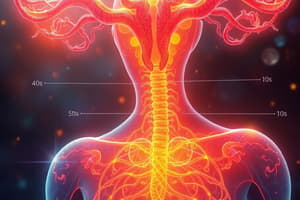Podcast
Questions and Answers
What primary function does CamScanner serve?
What primary function does CamScanner serve?
CamScanner is primarily used for scanning documents using a smartphone camera.
How does CamScanner improve the quality of scanned documents?
How does CamScanner improve the quality of scanned documents?
CamScanner enhances scanned documents through features like automatic cropping and image adjustment.
Name two formats in which CamScanner allows users to save their scanned documents.
Name two formats in which CamScanner allows users to save their scanned documents.
Users can save their scanned documents in PDF and JPEG formats.
What sharing options does CamScanner provide for scanned documents?
What sharing options does CamScanner provide for scanned documents?
Mention one security feature that CamScanner offers for enhancing document privacy.
Mention one security feature that CamScanner offers for enhancing document privacy.
Flashcards
CamScanner
CamScanner
An application for digitizing documents or capturing images, often used to scan and save paper documents.
Document Digitization
Document Digitization
Converting paper documents into digital images.
Image Capture
Image Capture
Using a device to record a visual image.
Mobile App
Mobile App
Signup and view all the flashcards
Document Management
Document Management
Signup and view all the flashcards
Study Notes
Endocrine System
- Endocrine and nervous systems communicate in the body
- Nervous system is faster than the endocrine system
- Endocrine response is not always slower; examples include norepinephrine and insulin
- Endocrine system functions include homeostasis, growth regulation, reproduction regulation, and maturation regulation
Hormone Classification
- Steroid Hormone: Derived from cholesterol, insoluble in blood, requiring protein transporters
- Protein Hormone: Protein in nature, soluble in blood, does not need transporters, hydrophobic-lipophilic/hydrophilic-lipophilic, act on intracellular or extracellular receptors.
Types of Hormones
-
Thyroid Hormone: Crosses cell membranes, stored in follicles, transported in blood via proteins, act on intracellular receptors, long half-life
-
Catecholamines: Do not cross cell membranes, stored in granules, transported in blood freely or loosely bound to proteins, act on extracellular receptors, short half-life
-
Amines: Hormones derived from tyrosine; act on intracellular (nuclear) or extracellular receptors
Hormone Receptors
- Function as glycoprotein structures that bind with hormones (lock-and-key theory)
- Physiological conditions, other hormones, and hormones acting on receptors affect hormone quality, quantity, and sensitivity
Hormone Regulation
- Example of Up-regulation: During parturition, oxytocin hormone leads to an increase in oxytocin receptors as estrogen hormone also increases receptor sensitivity.
- Example of Down-regulation: Insulin regulation decreases receptor synthesis and decreases receptor numbers when hormone levels are high
Hormone Action
- Autocrine action: Hormone acts within the organ of synthesis (e.g., testosterone influencing testes)
- Paracrine action: Hormone acts on nearby cells (e.g., somatostatin affecting nearby cells)
- Endocrine action: Hormone is produced by ductless endocrine glands and released into the blood (e.g., insulin and glucagon secretion)
Mechanism of Action of Protein Hormones
- Hormone is the first messenger, binding with receptors to start biochemical reactions
- Second messengers form, e.g., cAMP (adenyl cyclase), phosphatidyl inositol system, calcium calmodulin system, and tyrosine kinase system
- Examples of hormones using this pathway include epinephrine, norepinephrine, glucagon, and calcitonin
Mechanism of Action of Steroid and Thyroid Hormones
- Hormone binds with intracellular receptors, forming a hormone-receptor complex (HRC) to cause DNA sequence changes
- Receptors have ligand-binding, DNA-binding, and N-terminal domains
- This affects the transcription of specific genes, producing a specific protein.
Phosphatidyl Inositol System
- Hormone binding triggers conformational changes in HAC
- This activates phospholipase C, hydrolyzing PIP₂ into IP₃ and DAG
- IP₃ mobilizes Ca²⁺ from intracellular stores
- DAG stimulates protein kinase C (PKC)
- PKC phosphorylates enzymes, impacting transcription and causing changes
Calcium Calmodulin System
- In muscle and nerve cells, calcium ions (Ca²⁺) act as second messengers
- Ca²⁺ is released from the ER, and activation of Ca-calmodulin-dependent protein kinase
- Kinase phosphorylates target enzymes.
Studying That Suits You
Use AI to generate personalized quizzes and flashcards to suit your learning preferences.




